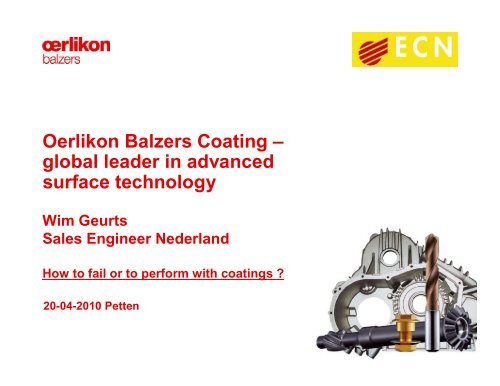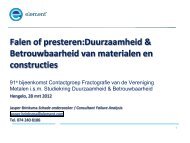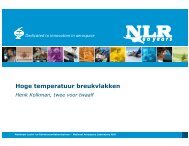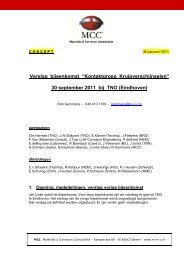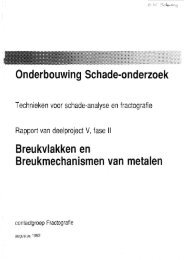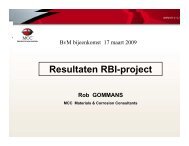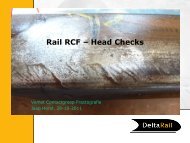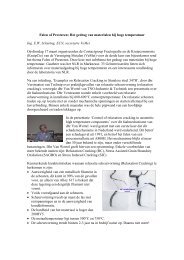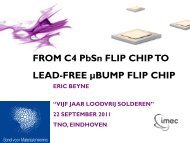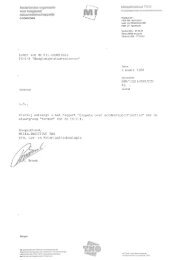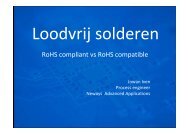Oerlikon Balzers Coating – global leader in advanced ... - VeMet
Oerlikon Balzers Coating – global leader in advanced ... - VeMet
Oerlikon Balzers Coating – global leader in advanced ... - VeMet
Create successful ePaper yourself
Turn your PDF publications into a flip-book with our unique Google optimized e-Paper software.
<strong>Oerlikon</strong> <strong>Balzers</strong> <strong>Coat<strong>in</strong>g</strong> <strong>–</strong><br />
<strong>global</strong> <strong>leader</strong> <strong>in</strong> <strong>advanced</strong><br />
surface technology<br />
Wim Geurts<br />
Sales Eng<strong>in</strong>eer Nederland<br />
How to fail or to perform with coat<strong>in</strong>gs ?<br />
20-04-2010 Petten
Company Overview <strong>–</strong> Six core competencies<br />
<strong>Oerlikon</strong><br />
Textile<br />
<strong>Oerlikon</strong><br />
<strong>Coat<strong>in</strong>g</strong><br />
Page 2 Bus<strong>in</strong>ess Unit <strong>Oerlikon</strong> <strong>Balzers</strong> / July<br />
2009<br />
<strong>Oerlikon</strong><br />
Solar<br />
<strong>Oerlikon</strong><br />
Vacuum<br />
<strong>Oerlikon</strong><br />
Drive Systems<br />
1<br />
<strong>Oerlikon</strong><br />
Advanced<br />
Technologies<br />
1<br />
Discont<strong>in</strong>ued operations
Key data for Bus<strong>in</strong>ess Unit <strong>Oerlikon</strong> <strong>Balzers</strong><br />
§ Unique company with <strong>global</strong> network for coat<strong>in</strong>g service<br />
§ Nearly 90 coat<strong>in</strong>g centres <strong>in</strong> more than<br />
30 countries<br />
§ CHF 509 million sales <strong>in</strong> 2008<br />
§ About 2900 employees worldwide<br />
§ About 30% <strong>global</strong> market share<br />
(job coat<strong>in</strong>g)<br />
§ Approximately 3.5 times bigger<br />
than the No. 2<br />
§ More than 550 coat<strong>in</strong>g systems<br />
<strong>in</strong> operation<br />
Page 3 Bus<strong>in</strong>ess Unit <strong>Oerlikon</strong> <strong>Balzers</strong> / July<br />
2009
Close to you <strong>–</strong> anywhere <strong>in</strong> the world<br />
22 Centres 40 Centres<br />
24 Centres<br />
America<br />
Argent<strong>in</strong>a<br />
Brazil<br />
Canada<br />
Mexico<br />
USA<br />
Page 4 Bus<strong>in</strong>ess Unit <strong>Oerlikon</strong> <strong>Balzers</strong> / July<br />
2009<br />
Europe<br />
Liechtenste<strong>in</strong><br />
Austria<br />
Benelux<br />
Czech Rep.<br />
F<strong>in</strong>land<br />
France<br />
Germany<br />
Great Brita<strong>in</strong><br />
Hungary<br />
Italy<br />
Poland<br />
Portugal<br />
Romania<br />
Spa<strong>in</strong><br />
Sweden<br />
Switzerland<br />
Turkey<br />
Asia<br />
Ch<strong>in</strong>a<br />
India<br />
Indonesia<br />
Japan<br />
Korea<br />
S<strong>in</strong>gapore<br />
Thailand<br />
As of June 2009
<strong>Oerlikon</strong> <strong>Balzers</strong> <strong>Coat<strong>in</strong>g</strong> Benelux<br />
Management:<br />
David Franz<br />
Market<strong>in</strong>g:<br />
Willy Boghe<br />
Sales:<br />
Mathieu Desmet (B)<br />
Wim Geurts (NL)<br />
Product Management:<br />
John Bexkens<br />
Renaud Cuis<strong>in</strong>ier<br />
Quality & ISO system:<br />
Tim Dètre<br />
Customer Service:<br />
Sylvia Pieraerts<br />
Greet Duchateau<br />
Sales Support:<br />
Kathleen Aerts<br />
Natalie Thierie<br />
<strong>Oerlikon</strong> <strong>Balzers</strong> <strong>Coat<strong>in</strong>g</strong> Benelux<br />
Postbus 6180<br />
NL-4000 HD TIEL<br />
Tel. +31 344 655 490<br />
Fax +31 344 655 287<br />
<strong>Oerlikon</strong> <strong>Balzers</strong> <strong>Coat<strong>in</strong>g</strong> Benelux<br />
Schurhovenveld 4 050<br />
B-3800 SINT-TRUIDEN<br />
Tel. +32 11 69 30 40<br />
Fax +32 11 69 29 45<br />
<strong>Oerlikon</strong> <strong>Balzers</strong> <strong>Coat<strong>in</strong>g</strong> Luxembourg<br />
B.P. 63<br />
L-4501 DIFFERDANGE<br />
Tel. +352 26 58 08 91<br />
Fax +352 26 58 08 92<br />
Pick-up service<br />
available on request
Lead<strong>in</strong>g companies rely on us<br />
§ Tool manufacturers<br />
§ Automotive <strong>in</strong>dustry<br />
§ Aircraft <strong>in</strong>dustry<br />
§ Metalwork<strong>in</strong>g <strong>in</strong>dustry<br />
§ Plastics process<strong>in</strong>g <strong>in</strong>dustry<br />
§ Mechanical eng<strong>in</strong>eer<strong>in</strong>g and<br />
plant construction<br />
Page 6 Bus<strong>in</strong>ess Unit <strong>Oerlikon</strong> <strong>Balzers</strong> / July<br />
2009
Manufactur<strong>in</strong>g flow for tool coat<strong>in</strong>g<br />
Pick up Job order<strong>in</strong>g Clean<strong>in</strong>g<br />
Batch load<strong>in</strong>g <strong>Coat<strong>in</strong>g</strong> Packag<strong>in</strong>g / dispatch<br />
Page 7 Bus<strong>in</strong>ess Unit <strong>Oerlikon</strong> <strong>Balzers</strong> / July<br />
2009
BALINIT ® -one brand for many applications / History of 30 years<br />
Carbon-based coat<strong>in</strong>gs<br />
Hard coat<strong>in</strong>gs<br />
BALINIT ® A<br />
BALINIT ® C<br />
BALINIT ® G<br />
BALINIT ® B<br />
BALINIT ® BALINIT<br />
D<br />
® CAST<br />
BALINIT ® DLC<br />
BALINIT ® TRITON<br />
BALINIT ® LUMENA<br />
BALINIT ® X.CEED<br />
BALINIT ® FUTURA NANO<br />
BALINIT ® HARDLUBE<br />
BALINIT ® FUTURA<br />
BALINIT ® C STAR<br />
BALINIT ® DLC STAR<br />
BALINIT ® HELICA<br />
BALINIT ® ALCRONA<br />
BALINIT ® CROVEGA<br />
BALINIT ® DIAMOND<br />
BALINIT ® ALDURA<br />
TiN TiCN TiAlN WC/C AlTiN AlCr P3e TM<br />
1980 1990 2000 2007
Characteristics of BALINIT ® <strong>Coat<strong>in</strong>g</strong>s for tools<br />
§BALINIT coat<strong>in</strong>g portfolio : typical applications
Comparison on scale of hardness<br />
Diamant<br />
BNc<br />
X.TREME<br />
FUT NANO<br />
TiCN<br />
TiN<br />
CrN<br />
Hardmetaal<br />
Nitreerlagen<br />
Hardchroom<br />
Snelstaal (64 HRC)<br />
Warmarbeidsstaal<br />
0 2000 4000 6000 8000 10000<br />
Hardness (HV)
Wear resistant BALINIT ® coat<strong>in</strong>gs for tools<br />
Cutt<strong>in</strong>g<br />
Tool life<br />
Productivity<br />
Punch<strong>in</strong>g/<br />
form<strong>in</strong>g<br />
Tool life<br />
Dry runn<strong>in</strong>g<br />
Plastics process<strong>in</strong>g<br />
Mould protection<br />
Shorter cycle times<br />
Die cast<strong>in</strong>g<br />
Wear resistance
BALINIT ® coat<strong>in</strong>gs for precision components<br />
Gears Eng<strong>in</strong>e components Hydraulic<br />
Compressor parts
Wear protection coat<strong>in</strong>gs for precision components<br />
Page 13 Bus<strong>in</strong>ess Unit <strong>Oerlikon</strong> <strong>Balzers</strong> / July<br />
2009<br />
Rocker arm<br />
Injection system
Wat zijn PVD coat<strong>in</strong>gs ?<br />
Physical Vapour Deposition<br />
qAre attached at temperatures<br />
between 200 and 480 °C<br />
q Thickness of the coat<strong>in</strong>g 1-16 µm<br />
Standard : 3<strong>–</strong>1 µm<br />
Th<strong>in</strong> (reamerproces) : <strong>–</strong>1 µm<br />
Special : <strong>–</strong>16 µm<br />
q Strong adhesion of the coat<strong>in</strong>gs<br />
q High hardness and low coëfficiënt of friction.
Thickness of the coat<strong>in</strong>g <strong>in</strong> comparison<br />
Human hair<br />
0.05 mm<br />
BALINIT ® hard coat<strong>in</strong>g<br />
0.003 mm<br />
Page 15 Bus<strong>in</strong>ess Unit <strong>Oerlikon</strong> <strong>Balzers</strong> / July<br />
2009
Thickness of the coat<strong>in</strong>g<br />
1<br />
1 µm = mm<br />
1000<br />
hair: 50 - 100 µm<br />
coat<strong>in</strong>g: 3 à 4µm
PVD - coat<strong>in</strong>g BALINIT ®<br />
•Only 0,003 mm<br />
thickness.<br />
•Harder then<br />
steel.<br />
•Ceramic<br />
properties<br />
•Follows surface<br />
structure<br />
exactly.
IBAD (Ion Beam Assisted Deposition)
Ionplat<strong>in</strong>g-process<br />
C.B6.04 (0204) e<br />
Argon<br />
Substrat<br />
e<br />
Crucible (Anode)<br />
< 500°C<br />
Hot filament cathode<br />
<strong>Coat<strong>in</strong>g</strong> material<br />
Reactive gas<br />
Substrates<br />
Low voltage<br />
arc discharge<br />
Vacuum pump
AIP (Arc Ion-Plat<strong>in</strong>g)<br />
RCS BAI1200
Arc evaporation-process<br />
C.B6.05 (0204) e<br />
Argon<br />
< 500°C<br />
Substrates<br />
Reactive gas<br />
Arc sources<br />
Vacuum pump
Sputter process<br />
BAI830C
Enhanced Sputter-process<br />
C.B6.02 (0304) e<br />
Argon<br />
< 250°C<br />
Substrates<br />
Hot filament cathode<br />
Auxiliary anode Low voltage arc discharge<br />
Reactive gas<br />
Planar Magnetron-<br />
Sputter<strong>in</strong>g source<br />
(coat<strong>in</strong>g material)<br />
Vacuum pump
What are CVD coat<strong>in</strong>gs ?<br />
q Are attached <strong>in</strong> vacuüm at temperatures<br />
>800 °C<br />
Chemical Vapour Deposition
Cross section of PVD- and CVD- coat<strong>in</strong>g (TiN) on<br />
cemented carbide<br />
1 µm<br />
PVD-coated (BALINIT ® A)<br />
1 µm<br />
CVD-coated
Difference PVD CVD<br />
Procestemperatuur<br />
Hecht<strong>in</strong>g van de coat<strong>in</strong>g<br />
Microstructuur van de coat<strong>in</strong>g<br />
Invloed op het substraat<br />
Interne spann<strong>in</strong>gen van de coat<strong>in</strong>g<br />
Snijkant hardmetaal<br />
Coatbaarheid scherpe sneden<br />
Dikte<br />
Ruwheid van de coat<strong>in</strong>g<br />
Coatbaarheid cermets<br />
PVD<br />
2µm<br />
Neen<br />
Verwijder<strong>in</strong>g metaalchloriden
Leap <strong>in</strong>to<br />
a new Dimension
Innovative new technologies<br />
P3e TM Technology<br />
(Pulse enhanced electron emission)<br />
§ Metal oxide coat<strong>in</strong>gs of corundum type structure<br />
§ Opens a new field of applications for PVD<br />
§ Thick coat<strong>in</strong>gs possible<br />
§ Large degree of freedom <strong>in</strong> design<strong>in</strong>g coat<strong>in</strong>g<br />
structures and coat<strong>in</strong>g properties<br />
Page 28 Bus<strong>in</strong>ess Unit <strong>Oerlikon</strong> <strong>Balzers</strong> / July<br />
2009<br />
New coat<strong>in</strong>g system INNOVA<br />
§ With P3e TM technology or with standard<br />
technology<br />
§ New etch<strong>in</strong>g process<br />
§ High flexibility
INNOVA. The future of tool coat<strong>in</strong>g<br />
P3e TM -Technology Pulsed Enhanced Electron Emission<br />
Al 2 O 3 layers deposited <strong>in</strong> PVD process below 600°C<br />
New pulsed technology<br />
New etch<strong>in</strong>g technology<br />
High pressures processes<br />
NADJA upgrade arc sources<br />
Equipment available<br />
<strong>in</strong> Tiel s<strong>in</strong>ce 12/2008<br />
§Why PVD coat<strong>in</strong>gs
Thick layers are possible<br />
16 μm<br />
Multilayer<br />
oxide coat<strong>in</strong>g<br />
TiAlN base
Thermal stability<br />
Inserts heated at 1000°C, 30 m<strong>in</strong>utes, on air<br />
uncoated TiCN P3e TM<br />
Carbide substrate (WC, Co)<br />
completely oxidized (blue<br />
colour due to Co-oxide)<br />
TiCN coat<strong>in</strong>g oxidizes,<br />
no protection of<br />
carbide substrate<br />
(Al,Cr) 2 O 3<br />
(Al,Cr) 2 O 3 protects<br />
carbide substrate at<br />
high temperatures<br />
from oxidation
Comparison P3e TM to standard PVD and CVD<br />
Properties PVD<br />
Deposition temperature<br />
Residual stress of coat<strong>in</strong>g<br />
Toughness<br />
Thermal cracks<br />
Maximum coat<strong>in</strong>g thickness<br />
α-Al 2 O 3<br />
500° C<br />
compressive<br />
high<br />
no<br />
6 µm<br />
P3e TM comb<strong>in</strong>es beneficial properties of PVD and CVD<br />
no<br />
CVD<br />
1000° C<br />
tensile<br />
low<br />
yes<br />
> 20 µm<br />
yes<br />
P3e TM<br />
500 - 600° C<br />
adjustable<br />
high<br />
no<br />
> 10 µm<br />
(Al,Cr) 2 O 3<br />
Corundum
First P3e TM alum<strong>in</strong>ium oxide coat<strong>in</strong>g<br />
X3turn
<strong>Coat<strong>in</strong>g</strong> structure of X3turn<br />
(Al,Cr) 2 O 3 corundum structure<br />
Chemical and thermal wear resistance<br />
TiAlN<br />
Mechanical wear resistance<br />
Cemented carbide substrate
Turn<strong>in</strong>g: equivalent to exist<strong>in</strong>g benchmarks<br />
Tool life [m<strong>in</strong>]<br />
14<br />
12<br />
10<br />
8<br />
6<br />
4<br />
2<br />
0<br />
v c = 175 m/m<strong>in</strong> v c = 200 m/m<strong>in</strong><br />
Tool<br />
Insert, CNMG120408<br />
<strong>Coat<strong>in</strong>g</strong> thickness 13 µm<br />
Workpiece<br />
Steel DIN 1.1221 (~AISI 1060)<br />
Cutt<strong>in</strong>g data<br />
f = 0.25 mm/rev<br />
a p = 2 mm<br />
VB max = 0.3 mm<br />
dry<br />
CVD Benchmark<br />
Tool manufacturer<br />
X3turn<br />
Source: Tool manufacturer
BALINIT ® DIAMOND
Properties of BALINIT ® DIAMOND<br />
CH 4<br />
H 2<br />
Result<br />
BALINIT ®<br />
DIAMOND<br />
C<br />
8-10000<br />
0,1<br />
6 - 20<br />
≈ 600<br />
grey<br />
800<br />
Composition<br />
Microhardness<br />
(HV 0,05)<br />
Coefficient of friction<br />
aga<strong>in</strong>st alum<strong>in</strong>ium<br />
(dry)<br />
Thickness (µm)*<br />
Max. temperature of<br />
use (°C)<br />
Colour<br />
<strong>Coat<strong>in</strong>g</strong>temp. (°C)
BALINIT ® DIAMOND
BALINIT ® <strong>Coat<strong>in</strong>g</strong>s: BALINIT ® DIAMOND<br />
1. Organic compounds:<br />
• Graphite<br />
• Composites (carbon fibers+epoxy, glass<br />
fibers+polyesters, …)<br />
• Re<strong>in</strong>forced plastics, honeycomb, foam, …<br />
2. Semi-organic compounds:<br />
• Sandwich (Glare ® , carbon-epoxy + Al alloys and/or<br />
Ti, …)<br />
• MMC (Al bases, Duralcan ® )<br />
3. Metallic compounds<br />
• Al-Si alloys (with or without Cu)<br />
• Al series 2000 and 7000 (under dry conditions)<br />
• <strong>in</strong> general non-ferrous alloys (plat<strong>in</strong>um, palladium,<br />
…)
PPD - Pulse Plasma<br />
Diffusion Mach<strong>in</strong>e<br />
With the <strong>in</strong>tegrated PPD<br />
technology, <strong>Balzers</strong> VST<br />
has set a new <strong>in</strong>dustry<br />
standard for the life long<br />
protection of cast iron<br />
tool<strong>in</strong>g. Not only the<br />
maximum dimensions<br />
(largest vessel <strong>in</strong> the US),<br />
but new milestones have<br />
been set <strong>in</strong> quality of<br />
treatment, diffusion depth,<br />
surface f<strong>in</strong>ish and process<br />
control.<br />
Advanced PVD -<br />
Physical Vapour<br />
Deposition Chamber<br />
A new generation of<br />
PVD coat<strong>in</strong>gs <strong>in</strong>creases<br />
the production up time<br />
on high strength<br />
structural parts that has<br />
only been seen possible<br />
with high temperature<br />
CVD coat<strong>in</strong>gs. The<br />
Advanced PVD coat<strong>in</strong>gs<br />
reduce the need for<br />
additional lubrication<br />
sav<strong>in</strong>g cost and the<br />
environment.<br />
<strong>Oerlikon</strong> <strong>Balzers</strong> VST<br />
PA-CVD- Plasma<br />
Activated Chemical<br />
Vapour Deposition<br />
Chamber<br />
Specially designed<br />
and developed<br />
coat<strong>in</strong>gs for the<br />
trimm<strong>in</strong>g and form<strong>in</strong>g<br />
of Alum<strong>in</strong>ium parts.<br />
Alum<strong>in</strong>ium parts used<br />
to reduce the weight of<br />
the vehicle and<br />
improve fuel efficiency<br />
br<strong>in</strong>g there own varied<br />
set of production<br />
problems which can<br />
be elim<strong>in</strong>ated with<br />
<strong>Balzers</strong> VST's a-C:H<br />
coat<strong>in</strong>gs.<br />
Metallurgic Laboratory<br />
Extensive test<strong>in</strong>g of<br />
coat<strong>in</strong>gs and metals, with<br />
100% quality control of all<br />
treatments and processes<br />
<strong>Oerlikon</strong> <strong>Balzers</strong> VST Schopfheim
BALINIT ARCTIC coat<strong>in</strong>g series
Wear protection coat<strong>in</strong>gs for tools<br />
Punch<strong>in</strong>g / Form<strong>in</strong>g<br />
Plastics process<strong>in</strong>g<br />
Low tempered steels are used<br />
<strong>Coat<strong>in</strong>g</strong> temperature of 200°Cis requested<br />
General eng<strong>in</strong>eer<strong>in</strong>g
What does ARCTIC mean ?<br />
ARCTIC coat<strong>in</strong>g series<br />
- BALINIT ® A ARCTIC<br />
- BALINIT ® D ARCTIC<br />
- BALINIT ® FUTURA NANO ARCTIC<br />
Deposited at 200°C
BALINIT ® ARCTIC coat<strong>in</strong>g series<br />
§ <strong>Coat<strong>in</strong>g</strong> temperature at 200°C has the benefits of<br />
<strong>–</strong> no loss of hardness for low tempered steel grades<br />
<strong>–</strong> no effect on corrosion resistance<br />
<strong>–</strong> prevention of distortion<br />
§ BALINIT ® properties and performance are unaltered<br />
§ Excellent coat<strong>in</strong>g adhesion
No loss of hardness for low tempered steel grades<br />
68<br />
64<br />
60<br />
56<br />
52<br />
48<br />
44<br />
40<br />
Hardness [HRC]<br />
0 100 200 300 400 500 600 700<br />
Temper<strong>in</strong>g temperature [°C]<br />
Temper<strong>in</strong>g diagram<br />
for steel:<br />
K107<br />
(1.2436)<br />
Standard coat<strong>in</strong>g<br />
temperature<br />
ARCTIC coat<strong>in</strong>g<br />
temperature
No effect on corrosion resistance<br />
120<br />
100<br />
80<br />
60<br />
40<br />
Corrosion resistance [%]<br />
0 100 200 300 400 500 600 700<br />
Temper<strong>in</strong>g temperature [°C]<br />
Temper<strong>in</strong>g diagram<br />
for steel:<br />
M310<br />
(1.2083)<br />
Standard coat<strong>in</strong>g<br />
temperature<br />
ARCTIC coat<strong>in</strong>g<br />
temperature
Prevention of distortion<br />
0.15<br />
0.1<br />
0.05<br />
0<br />
-0.05<br />
-0.1<br />
-0.15<br />
Dimensional change [%]<br />
0 100 200 300 400 500 600 700<br />
Temper<strong>in</strong>g temperature [°C]<br />
Temper<strong>in</strong>g diagram<br />
for steel:<br />
M310<br />
(1.2083)<br />
Standard coat<strong>in</strong>g<br />
temperature<br />
ARCTIC coat<strong>in</strong>g<br />
temperature
ARCTIC coat<strong>in</strong>g series - properties<br />
BALINIT ® A ARCTIC<br />
(TiN)<br />
Hardness 2300 HV<br />
- abrasive wear resistance<br />
- adhesive wear resistance<br />
BALINIT ® D ARCTIC<br />
(CrN)<br />
Hardness 1750 HV<br />
- adhesive wear resistance<br />
- corrosion resistance<br />
- oxidation resistance<br />
Deposition temperature 200°C<br />
Max. coat<strong>in</strong>g thickness 5-6 μm (depend<strong>in</strong>g on tool size)<br />
BALINIT ®<br />
FUTURA NANO ARCTIC<br />
(TiAlN)<br />
Hardness 3300 HV<br />
- abrasive wear resistance<br />
- high thermal stability<br />
- high oxidation resistance<br />
- high chemical stability
What are we able to coat?<br />
• Substrate size/weight:<br />
<strong>–</strong> Max.dimensions: 700 x 1000 mm (external SPC L1500)<br />
<strong>–</strong> Max.weight: 600 kg<br />
• Coatable material:<br />
<strong>–</strong> Metals like high speed steel, cold and hot work<strong>in</strong>g steel, sta<strong>in</strong>less steel, carbide, cermet.<br />
Requirements for hardened steels: temper<strong>in</strong>g temperature > coat<strong>in</strong>g temperature<br />
<strong>–</strong> Copper and Alum<strong>in</strong>ium type: please contact us<br />
• Surface f<strong>in</strong>ish and hardness:<br />
<strong>–</strong> Blank material: no oxide layer, not chromed, ….<br />
<strong>–</strong> Clean, free of residues: no silicone, no glue, no pa<strong>in</strong>t, no plastic, no burrs, ….<br />
<strong>–</strong> Roughness: Ra ≤ 0,3 µm and Rz ≤ 3 µm<br />
<strong>–</strong> Hardness to be 55 HRc or more to avoid eggshell effect.<br />
<strong>–</strong> Demagnetised if possible.<br />
• <strong>Coat<strong>in</strong>g</strong> zone:<br />
<strong>–</strong> Always a zone without coat<strong>in</strong>g, due to fixation of the tool<br />
<strong>–</strong> <strong>Coat<strong>in</strong>g</strong> <strong>in</strong>side holes is limited to 1D
Hotwork- Coldwork<br />
Coatable materials<br />
steel steel steel<br />
Pre-hardened<br />
steel Sta<strong>in</strong>less High Speed Steel Bronze Miscelannous<br />
1.2323 1.2083 1.1151 1.4002 1.3202 Ampco 8 Ferro Titanit<br />
1.2343 1.2316 1.1181 1.4006 1.3207 Ampco 18<br />
1.2344 1.2362 1.1191 1.4021 1.3243 Ampco 45 Durotherm 600<br />
1.2360 1.2363 1.1221 1.4028 1.3245 Ampco 83 (300°C)<br />
1.2365 1.2369 1.2307 1.4034 1.3247 Ampco 88 (450°C) Hastelloy<br />
1.2367 1.2376 1.2311 1.4057 1.3255 Ampco 95 (450°C)<br />
1.2567 1.2378 1.2312 1.4110 1.3333 Ampco M4 TiAl6V4<br />
1.2581 1.2379 1.2738 1.4112 1.3341 Ampco 940 (420°C)<br />
1.2603 1.2380 1.6582 1.4116 1.3342 Ampco 944 (450°C) Hardmetalen<br />
1.2606 1.2436 1.7225 1.4120 1.3343 Ampco 972 (500°C)<br />
1.2662 1.2601 1.4122 1.3344<br />
1.2678 1.2609 1.4125 1.3348 Hovadur K220 (420°C)<br />
1.2709 1.2631 1.4528 1.3355 Hovadur K265 (450°C)<br />
1.2744 1.2851 1.4542 Hovadur K350 (300°C)<br />
1.2777 1.3551 CPM Rex M4<br />
1.2799 Elmax CPM Rex T15 Moldmax LH (375°C)<br />
1.2885 CPM 9V M 390 PM ASP 23/ 30/ 60 Moldmax HH (315°C)<br />
1.2889 CPM 10V S 390 PM<br />
1.6358 T440V S 690 PM<br />
Vanadis 4<br />
K190 PM<br />
SMV 5
Some examples….
Considerably higher service life with BALINIT ®<br />
Hobb<strong>in</strong>g of gears<br />
Manufactured parts<br />
4000<br />
3600<br />
3200<br />
2800<br />
2400<br />
2000<br />
4’100 pc.<br />
BALINIT® ALCRONA<br />
Page 52 Bus<strong>in</strong>ess Unit <strong>Oerlikon</strong> <strong>Balzers</strong> / July<br />
2009<br />
+ 80 %<br />
2’300 pc.<br />
AlTiN / Competitor<br />
Tool:<br />
PM-HSS hob<br />
Workpiece:<br />
Steel, DIN 1.7131 (~ AISI 5115)<br />
Cutt<strong>in</strong>g parameters:<br />
v c = 200 m/m<strong>in</strong><br />
VB ~ 0.3 mm<br />
Dry<br />
Source:<br />
Automotive manufacturer
F<strong>in</strong>ish<strong>in</strong>g carbon steel (C45E)<br />
Tool life [m<strong>in</strong>]<br />
100<br />
10<br />
Abrasive resistance<br />
TiCN<br />
TiAlN<br />
BALINIT ®<br />
ALCRONA<br />
Oxidation resistance<br />
Hot hardness<br />
200 300 400 500<br />
Parameters<br />
- End mill<strong>in</strong>g<br />
- F<strong>in</strong>ish<strong>in</strong>g<br />
- Coated carbide<br />
- Wet<br />
- VB max = 0.12 mm<br />
Cutt<strong>in</strong>g speed v C [m/m<strong>in</strong>]
lateral surface wear length after<br />
970.000 strokes [mm]<br />
16<br />
14<br />
12<br />
10<br />
8<br />
6<br />
4<br />
2<br />
0<br />
ALCRONA <strong>in</strong> punch<strong>in</strong>g & form<strong>in</strong>g<br />
TiN Alcrona<br />
TiN ALCRONA<br />
Explanation:<br />
Wear comparison TiN with<br />
Alcrona after 970.000<br />
strokes<br />
tool:<br />
Contour punch<br />
ASP23 (1.3344 HRC 64)<br />
workpiece:<br />
steel sheet C22<br />
thickness 1,25 mm<br />
Process parameter<br />
Frequency: 125 spm<br />
Punch<br />
displacement/stroke: 4mm
Ophangbeugel Ford Ka<br />
Materiaal : HLE (High Level Elasticity Steel) 4mm<br />
Gereedschap : 1.2379<br />
Mach<strong>in</strong>e : 1600 T - 14 Slag / m<strong>in</strong><br />
Smer<strong>in</strong>g : Pure olie<br />
Bron : Benteler Spanje<br />
Zonder coat<strong>in</strong>g Bal<strong>in</strong>t X-Cell<br />
Koudlas van de stempels na 300 000 Na 1 200 000 slagen nog geen slijtage<br />
Nog Steeds <strong>in</strong> gebruik
BALINIT® reduces production costs by 46 %<br />
Production of h<strong>in</strong>ges for Volvo tailgates<br />
Tool costs (EUR)<br />
Tool life (parts)<br />
Tool costs per part (EUR)<br />
Yield per m<strong>in</strong>. (parts)<br />
Production costs per m<strong>in</strong>. (EUR)<br />
Production costs per part (EUR)<br />
Mach<strong>in</strong>e downtime (EUR)<br />
Subsequent mach<strong>in</strong><strong>in</strong>g (EUR)<br />
Additional costs per part (EUR)<br />
Total production costs<br />
per part (EUR)<br />
Sav<strong>in</strong>gs<br />
Uncoated BALINIT ® C<br />
3‘445<br />
50‘000<br />
0.07<br />
28<br />
3.84<br />
0.14<br />
0.03<br />
0.04<br />
4‘065<br />
89‘600<br />
0.05<br />
38<br />
3.84<br />
0.10<br />
0.07 0.00<br />
0.28 0.15<br />
46 %
BALINIT A / nitrid<strong>in</strong>g<br />
number of parts<br />
(meanvalues)<br />
5.000.000<br />
4.000.000<br />
3.000.000<br />
2.000.000<br />
1.000.000<br />
0<br />
1.000.000<br />
5.000.000<br />
TIN TIN / Nitrid<strong>in</strong>g<br />
tool:<br />
Knife (divid<strong>in</strong>g)<br />
mat. 1.3344 (62 <strong>–</strong> 64 HRC) / Nitrid<strong>in</strong>g<br />
polished<br />
workpiece:<br />
1,00 mm sheet - thickness<br />
Mat. KBB S320GD+Z<br />
application:<br />
profiles cutt<strong>in</strong>g<br />
source: BFL
BALINIT ® boosts productivity by 20%<br />
Threaded cores for bottle caps<br />
Page 58 Bus<strong>in</strong>ess Unit <strong>Oerlikon</strong> <strong>Balzers</strong> / July<br />
2009<br />
Description<br />
Production process: <strong>in</strong>jection mould<strong>in</strong>g<br />
Particularity: lubricants and mould<br />
release agents cannot be used for<br />
pharmaceutical or food packag<strong>in</strong>g.<br />
Threaded cores uncoated<br />
Production downtime: 1 day per week<br />
Threaded cores BALINIT ® -coated<br />
§ Trouble-free production dur<strong>in</strong>g<br />
several months<br />
§ 10% shorter cycle times<br />
§ Yield productivity ga<strong>in</strong>s of up to 20%
Performance <strong>in</strong>crease by BALINIT ®<br />
Diesel <strong>in</strong>jector with piezo technology<br />
Image source:<br />
Siemens VDO<br />
Valve piston<br />
Poppet valve<br />
Control<br />
piston<br />
Injection<br />
needle<br />
Page 59 Bus<strong>in</strong>ess Unit <strong>Oerlikon</strong> <strong>Balzers</strong> / July<br />
2009<br />
Components of the <strong>in</strong>jector out of a Common-Rail<br />
diesel <strong>in</strong>jection system are coated with performance<br />
<strong>in</strong>creas<strong>in</strong>g carbon coat<strong>in</strong>gs <strong>in</strong> mass-production.<br />
BALINIT ® DLC-coated <strong>in</strong>jection needles are<br />
dimensionally stable even <strong>in</strong> long-term usage, thus<br />
ensur<strong>in</strong>g the leak tightness of the system. The good<br />
slid<strong>in</strong>g properties guarantee a precise flow of the<br />
diesel fuel.<br />
BALINIT ® C-coated valve pistons virtually show no<br />
wear even at extreme pressures.
Cyl<strong>in</strong>drical roller thrust bear<strong>in</strong>g<br />
Life time [hours]<br />
> 250<br />
R<strong>in</strong>gs and rollers<br />
BALINIT ® C coated<br />
Temperature: 30 °C<br />
Coefficient of friction: 0.004<br />
Roller wear: 5 mg<br />
1.5 1,5<br />
uncoated<br />
Bear<strong>in</strong>g 81206<br />
Load: 33 kN<br />
Cage material: PA 66<br />
Speed: 15 rpm<br />
Dry runn<strong>in</strong>g
BALINIT ® coat<strong>in</strong>gs for highly demand<strong>in</strong>g components<br />
Be<strong>in</strong>g part of all successful formula 1 rac<strong>in</strong>g cars<br />
Cam follower<br />
(rocker arm and shaft, tappets)<br />
Valves<br />
Camshafts<br />
Page 61 Bus<strong>in</strong>ess Unit <strong>Oerlikon</strong> <strong>Balzers</strong> / July<br />
2009<br />
Gear wheels<br />
Suspension parts<br />
Pistons<br />
Wrist p<strong>in</strong>s<br />
Con rods<br />
Crank shaft
Summary of advantages of BALINIT ® coat<strong>in</strong>gs<br />
§ Longer lifetime of parts / tools<br />
§ Reduced friction<br />
§ Better (product)release<br />
§ Less corrosion<br />
§ Less ma<strong>in</strong>tenance<br />
§ Lower weight due to smaller<br />
components<br />
§ Less oil/fuel consumption<br />
§ Reduced emission<br />
§ Possibilty of replac<strong>in</strong>g <strong>in</strong>expensive<br />
and/or tough materials aga<strong>in</strong>.<br />
Page 62 Bus<strong>in</strong>ess Unit <strong>Oerlikon</strong> <strong>Balzers</strong> / July<br />
2009
How to fail or to perform with coat<strong>in</strong>gs ?<br />
§BALINIT coat<strong>in</strong>g portfolio : typical applications
Most important forms of damage.<br />
Abrasive wear<br />
Adhesive wear<br />
Break<strong>in</strong>g out<br />
Plastic deformation<br />
Breakage
Causes of different forms of wear<br />
Type of wear<br />
Plastic<br />
deformation<br />
Brittle crack<br />
Break<strong>in</strong>g out<br />
Chipp<strong>in</strong>g<br />
Abrasive<br />
wear<br />
Adhesive wear<br />
(Coldweld<strong>in</strong>g)<br />
Needed<br />
property<br />
Resistance aga<strong>in</strong>st<br />
deformation<br />
Resistance aga<strong>in</strong>st<br />
breakage<br />
Resistance aga<strong>in</strong>st<br />
wear<br />
Lower<strong>in</strong>g friction<br />
+ surface tension<br />
Location Solution<br />
Mass<br />
Mass<br />
Surface<br />
Surface<br />
Type of steel +<br />
Heat treatment<br />
Type of steel +<br />
Heat treatment<br />
Type of steel +<br />
Heat treatment +<br />
coat<strong>in</strong>g<br />
Surfaceproperties +<br />
coat<strong>in</strong>g
How do we prepare a surface ?<br />
Interface<br />
Topography<br />
gr<strong>in</strong>ded<br />
Turned/milled<br />
blasted<br />
polished<br />
eroded<br />
Steam temper<br />
nitrided<br />
Hartchrom plated<br />
Chem. Nickel<br />
photoetched<br />
Substrate<br />
- Geometry (e.g. cutt<strong>in</strong>g tool edge, topography)<br />
- Substrate (Strength, ductility, roughness)<br />
Influence of pretreatment to adhesion of PVD layer<br />
good pretreatment<br />
necessary<br />
not good<br />
plasmanitrided gasnitrided bathnitrided
Gr<strong>in</strong>d<strong>in</strong>g / Polish<strong>in</strong>g: tribological behaviour<br />
Friction Coefficient<br />
R z<br />
optimal<br />
Rz (mm )<br />
0 0,14 0,18 0,2<br />
0,26 0,34<br />
Ra [µm]<br />
<strong>Coat<strong>in</strong>g</strong> Topography<br />
20 µm
R a = 0.01<br />
μm<br />
R a = 0.04 μm<br />
R a = 0.1 μm<br />
Influence of the direction of surface roughness on<br />
Critical load (coat<strong>in</strong>g fracture) <strong>in</strong> scratch test<strong>in</strong>g of TiN on<br />
HSS<br />
R a = 0.3 μm<br />
Perpendicular to the grooves<br />
Parallel to the grooves<br />
Acceptable<br />
R a = 0.5 μm<br />
Not acceptable<br />
R a = 1μm
Roughness table
Roughness table of different methods
EDM surfaces<br />
• EDM surfaces can only be coated when they have had the<br />
right pretreatment (blast<strong>in</strong>g or gr<strong>in</strong>d<strong>in</strong>g).<br />
<strong>–</strong>Total removal of the white layer is crucial for tools / parts<br />
that are suffer<strong>in</strong>g under high loads .<br />
Microcrack Pore<br />
White layer<br />
Thermal <strong>in</strong>fluenced area<br />
Undamaged microstructure
White layer : microblast<strong>in</strong>g reduces the white layer<br />
thickness<br />
White layer after<br />
rough erosion<br />
White layer after three<br />
f<strong>in</strong>ish<strong>in</strong>g erosion steps<br />
Microbast<strong>in</strong>g<br />
Surface after<br />
microblast<strong>in</strong>g
Nitrid<strong>in</strong>g surfaces: compound layer def<strong>in</strong>es topography<br />
Picture: Nitrided Surface with white layer<br />
W400 (1.2343)<br />
magnifaction: x1000<br />
Picture: without white layer W400 (1.2343) gasnitrided,<br />
magnifaction: x1000<br />
Three common processes are usable for steel treatment (salt, gas, plasma).<br />
Plasma nitrid<strong>in</strong>g gives the best result to <strong>in</strong>crease hardness.<br />
It´s a stable proces which produces clean surfaces (no compound layer)<br />
Meanwhile we are able to comb<strong>in</strong>e plasmanitrid<strong>in</strong>g and PVD coat<strong>in</strong>g <strong>in</strong> one<br />
process; Bal<strong>in</strong>it Alcrona Advanced.
www.coat<strong>in</strong>g-guide.balzers.com<br />
• <strong>Coat<strong>in</strong>g</strong> Guide<br />
• Material library<br />
• <strong>Coat<strong>in</strong>g</strong>s <strong>in</strong>formation<br />
• Sample applications<br />
• <strong>Balzers</strong> world-wide
Thank you for your attention !


